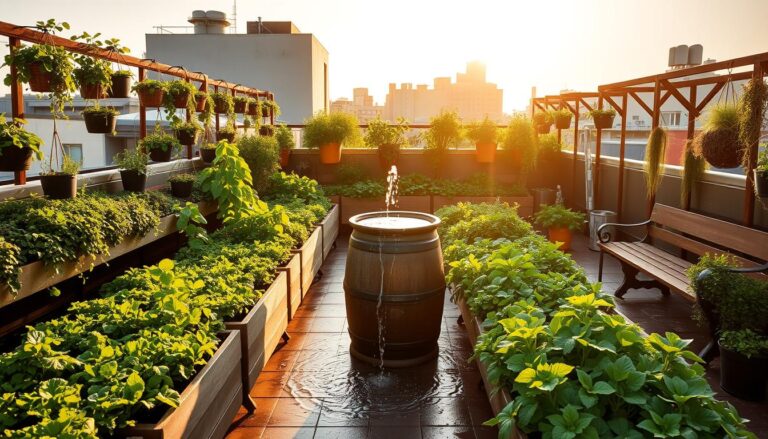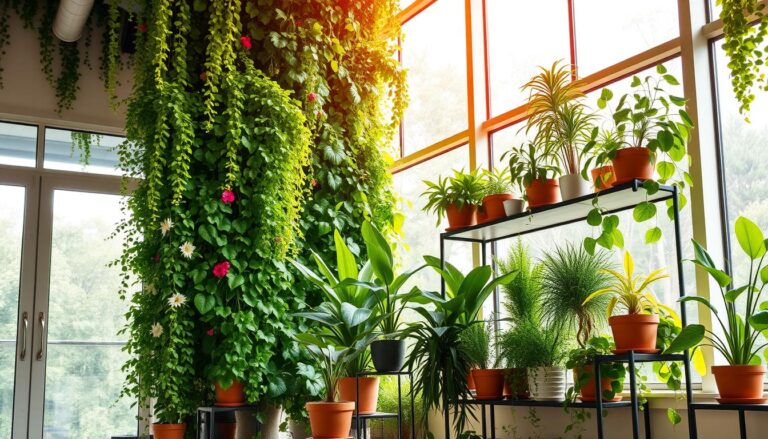Gardening is a mix of science and nature’s rhythm. Knowing when to plant different vegetables is key for a good harvest. A seasonal planting guide helps gardeners choose the right plants for each time of year. This way, they can enjoy a garden full of life all year long.
With a seasonal planting guide, gardeners learn what to plant from spring to winter. For instance, spring gardening has three mini-seasons based on when it’s frost-free. Planting early in spring, 2-3 weeks before it’s frost-free, is important for a successful garden. A good guide helps gardeners pick the best plants for each season and know what to grow all year.
A seasonal planting guide is a great tool for gardeners. It tells them the best plants for each season and what to grow all year. With this guide, gardeners can make their garden thrive in every season.
Key Takeaways
- Understanding the best time to plant various vegetables is key for a good harvest.
- A seasonal planting guide helps gardeners make smart choices about what to grow all year.
- Following nature’s cycles helps gardeners get the most from their garden.
- The best plants for each season change, and a good guide gives the needed info.
- Gardeners can make their garden flourish in every season with a seasonal planting guide.
- Learning what to plant each season is vital for a successful garden, and a guide helps with that.
Understanding the Basics of Seasonal Planting
To have a great garden, you need to know about seasonal planting. First, find out your USDA Hardiness Zone. This tells you which plants will grow well in your area. Use a gardening calendar to keep track of planting times.
Knowing the difference between cool-season and warm-season crops is important. Cool-season crops like broccoli and kale do best in spring and fall. Warm-season crops, such as tomatoes and peppers, need the summer heat. This knowledge helps you plan your garden well.
Think about what each plant needs when planning your garden. Most veggies need 6 to 8 hours of sunlight a day. A 10×10-foot garden is good for beginners. Raised beds warm up the soil faster in spring. With these tips and a seasonal guide, your garden will flourish.
- Cool-season crops: plant in early spring and fall
- Warm-season crops: plant in late spring and summer
- USDA Hardiness Zone: determines what plants can thrive in your area
- Gardening calendar: helps you stay organized and ensure you’re planting at the right time
By learning about seasonal planting and using a gardening calendar, you can have a successful garden. Remember to consider each plant’s needs and follow planting tips all year. This will help you enjoy your gardening journey.
Essential Garden Planning and Preparation
To make your garden vibrant and thriving all year, knowing what to plant and when is essential. A well-planned garden has plants that bloom or are ready to harvest at all times. This means deciding on your garden’s layout, preparing the soil, and picking the right plants for each season.
A perennial planting schedule helps gardeners plan ahead. It ensures their garden stays beautiful and productive all year. By following growing season recommendations, gardeners choose the best plants for each season. They consider climate, soil type, and sunlight.
- Deciding on the layout of your garden, considering the space and sunlight available
- Preparing the soil, adding organic matter and nutrients as needed
- Choosing the right plants for each season, considering factors such as climate, soil type, and sunlight
By following these steps and considering a perennial planting schedule and growing season recommendations, gardeners can create a beautiful and thriving garden. This garden brings joy and freshness to your outdoor space all year round.
Spring Planting Guide: Starting Your Garden Right
When the last frost goes away, it’s time to plant your garden. Planting at the right time is key for a healthy garden. In early spring, you can plant cool-season veggies like lettuce, spinach, and peas when the soil is ready.
In a seasonal veggie garden, planning is vital. For spring, start with broccoli, kale, and arugula in March. Then, add radishes, beets, carrots, dill, and cilantro a few weeks later.
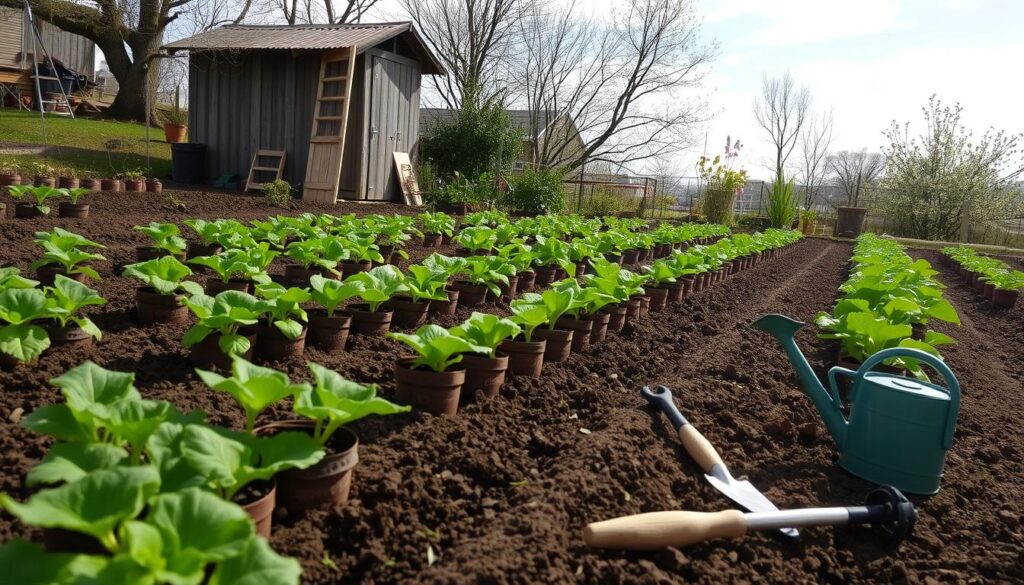
- Starting seeds indoors 4-6 weeks before transplanting outside
- Direct sowing seeds into the garden when the soil is workable
- Hardening off transplants for 1-2 weeks before planting them outdoors
By following these tips, you can grow a great seasonal veggie garden. This garden will give you fresh food all year. Don’t forget to use fertilizer and organic matter to keep your soil healthy.
Summer Growing Season: Heat-Loving Plants
Summer is here, and it’s time to pick plants that love the heat. A good seasonal planting guide is key. This season, many plants grow best, like beans, corn, and cucumbers. Flowers like sunflowers and zinnias also brighten up your garden.
Think about what each plant needs when planning your garden. For example, sweet potatoes can grow up to 40 pounds in Central Texas. Cowpeas can be picked in three ways: young, shelled, or dried. Yard Long Beans help shade plants that don’t like the sun.
Here are some summer veggies and what they need to grow well:
- Okra: needs daily picking to stay tender
- Summer squash: might need row covers and hand pollination to fight pests
- Melons: can produce about 200 pounds from just three vines
- Corn: needs lots of water and should be sweet kernel types for best taste
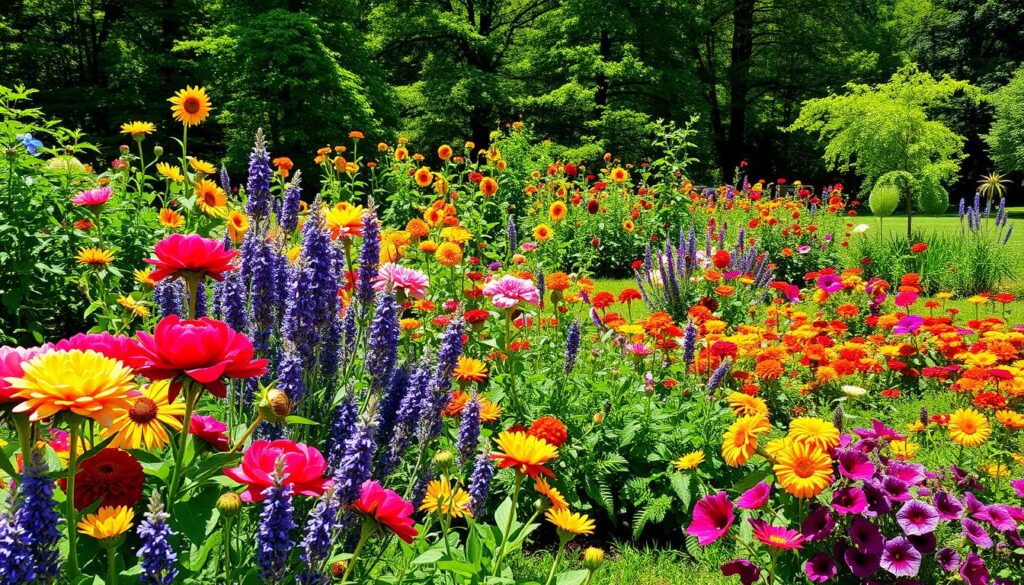
A seasonal planting guide helps you get ready for summer. It ensures a great harvest and a stunning garden. By picking the right plants and following a guide, you’ll enjoy your summer garden fully.
| Plant | Ideal Growing Conditions |
|---|---|
| Okra | Daily harvesting, full sun |
| Summer squash | Row covers, hand pollination, full sun |
| Melons | Full sun, well-draining soil |
| Corn | Significant water, sweet kernel varieties, full sun |
Seasonal Planting Guide: What to Grow Throughout the Year
To have a thriving garden, following a seasonal planting guide is key. It helps gardeners enjoy fresh produce all year. This guide ensures a healthy and productive garden.
Knowing when to plant is important. Cool-season veggies like broccoli and kale do well in spring and fall. Warm-season crops like tomatoes need summer’s heat. A monthly planting calendar helps plant the right crops at the right time.
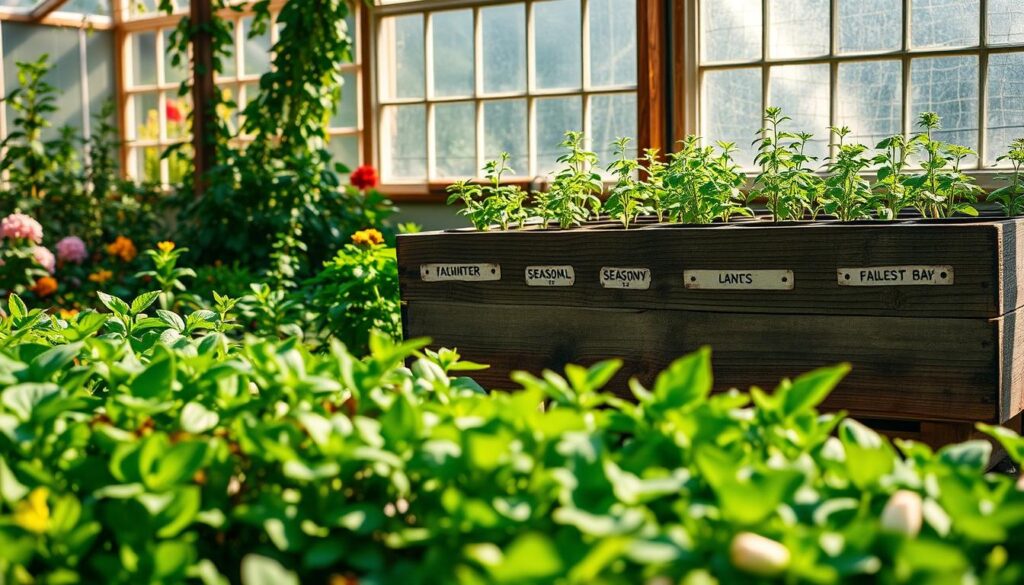
- Spring: peas, carrots, and radishes
- Summer: tomatoes, peppers, and zucchini
- Fall: broccoli, kale, and spinach
- Winter: Brussels sprouts, cabbage, and lettuce
By planting these crops, gardeners get a diverse and plentiful harvest. This way, they keep their garden thriving all year.
Crop rotation and succession planting also help. They keep the soil healthy, prevent pests, and extend the harvest. Following these tips leads to a productive garden. Gardeners enjoy fresh produce all year.
Fall Gardening: Making the Most of Cooler Weather
Fall is a great time to garden, thanks to the cooler weather. It’s perfect for planting cool-season vegetables. A gardening calendar and a seasonal crops guide help gardeners know when to plant.
Vegetables like broccoli, cauliflower, and kale do well in the fall. They can handle light frosts and are ready to harvest in the fall or early winter. Spinach and lettuce can be planted in the fall too. They’re ready to eat in just 20-30 days.
Fall is also a good time for planting flowers and ornamentals. Pansies and asters love the cooler weather of fall. They add color and beauty to gardens when many other plants are sleeping.
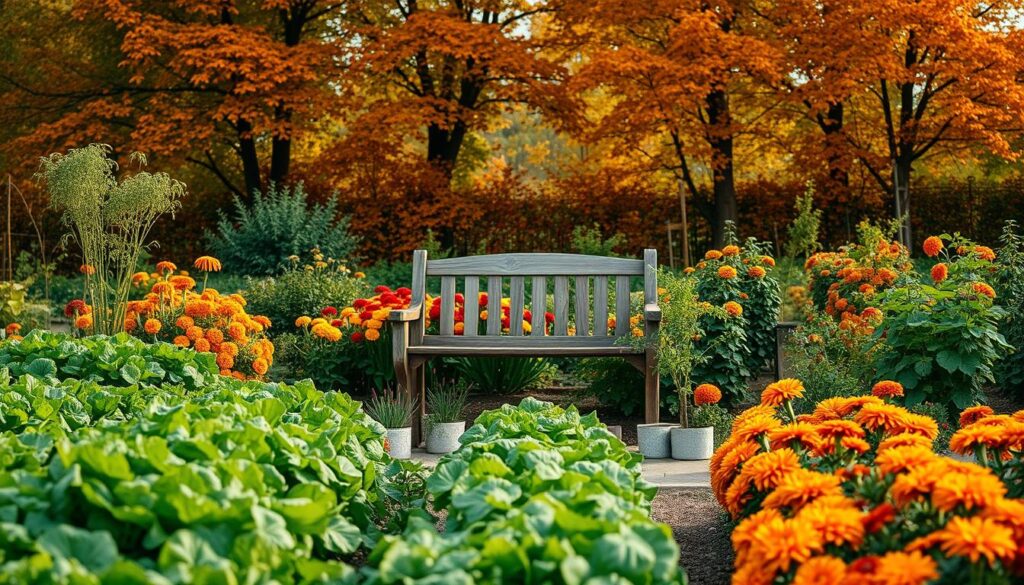
To get the most out of fall gardening, prepare for the first frost. Use a frost blanket or bring plants inside. This way, you can protect your plants and keep growing longer. With some planning, fall gardening can be fun and rewarding.
Here are some tips for fall gardening:
- Plant cool-season vegetables, such as broccoli and kale, 8-10 weeks before the first frost.
- Plant flowers and ornamentals, such as pansies and asters, in the fall for a burst of color.
- Prepare for the first frost by covering plants with a frost blanket or bringing them indoors.
Winter Garden Planning and Indoor Growing
When winter comes, many think gardening stops. But it doesn’t have to. Winter is a great time to plan and prepare for next year’s garden. By making a perennial planting schedule, your garden can stay vibrant all year. You can also pick the best plants for winter with growing season recommendations.
Rick Stone uses row covers and cold frames to grow longer. These tools let him plant hardy veggies like carrots and kale earlier. With a good perennial planting schedule and growing season recommendations, you can have a winter harvest.
Indoor growing is another winter option. Grow lights and indoor seeds can start the next season early. Crops like lettuce and spinach can grow indoors all year. With some planning, your garden can thrive in winter.
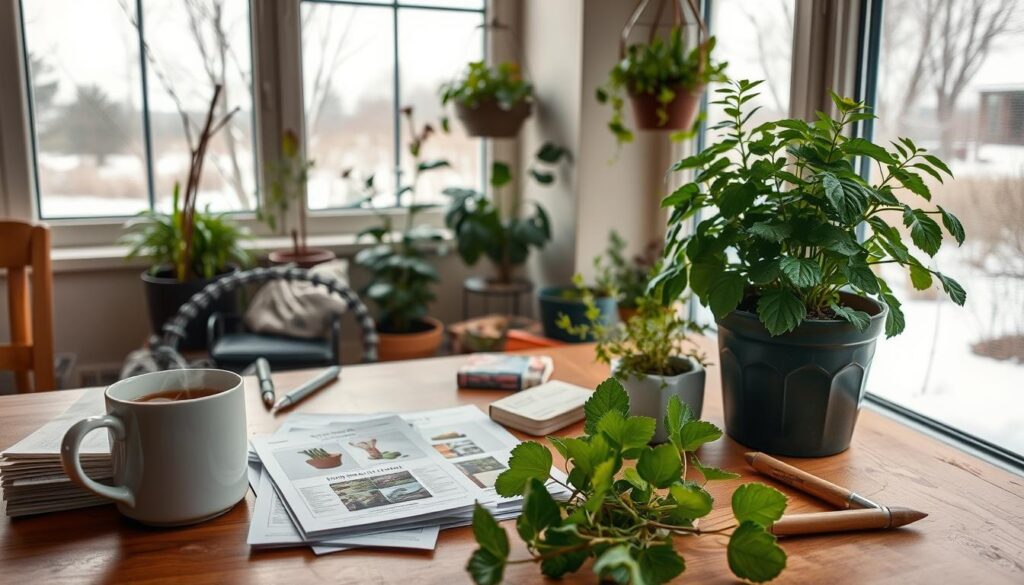
Ready to start winter garden planning and indoor growing? Here are some tips:
- Create a perennial planting schedule for next year’s garden
- Look up growing season recommendations for your area
- Use row covers and cold frames to grow longer
- Start seeds indoors with grow lights for an early start
Common Seasonal Growing Challenges and Solutions
Gardeners often face many challenges when planting by season. These can affect the health and productivity of their gardens. Weather-related issues like extreme temperatures, heavy rainfall, or drought are big challenges.
In a seasonal veggie garden, being ready for unexpected weather is key. Row covers can help keep air and soil temperatures stable. This can raise the growing temperature by 2-3°C (3.6-5.4°F). Straw or leaves can also protect soil and root vegetables from frost, reducing frost damage by up to 50%.
Managing pests by season is another challenge. Different pests are more common at different times. Knowing these patterns helps gardeners take the right action. For example, pest and weed problems drop by up to 70% in fall compared to summer.
Some common solutions for these challenges include:
- Using compost and organic fertilizers to boost soil nutrients
- Implementing crop rotation to fight pests and diseases
- Utilizing row covers and other barriers to shield plants from harsh weather
By understanding these challenges and solutions, gardeners can improve their planting by season. They can enjoy a healthy and productive seasonal veggie garden all year round.
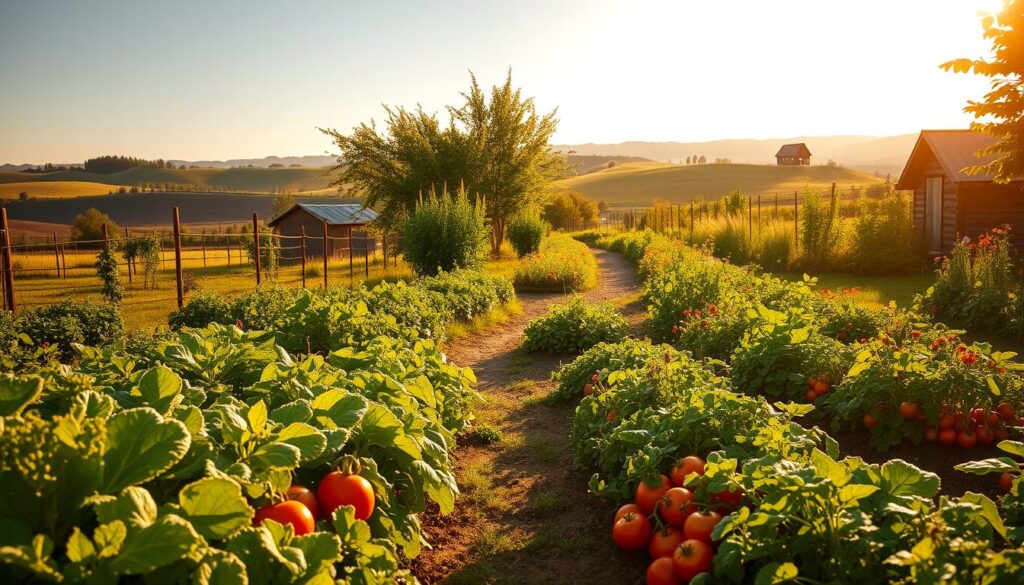
Here is a table summarizing some key challenges and solutions for seasonal growing:
| Challenge | Solution |
|---|---|
| Weather-related issues | Use row covers, straw, or leaves to protect plants |
| Pest management | Implement crop rotation, use physical barriers, and utilize organic fertilizers |
| Disease prevention | Use compost, maintain good soil health, and remove infected plants |
Conclusion: Creating Your Year-Round Garden Success
Creating a thriving garden all year is possible for gardeners of all levels. By matching your seasonal planting guide with nature’s cycles, you can make your garden productive. Enjoy fresh food all year, whether in raised beds, containers, or a traditional plot.
Choosing hardy veggies for cold weather and timing warm-weather plants right are key. This guide has given you the tools for a garden that grows all year. By following nature’s rhythms and using these strategies, you’ll achieve garden success anytime.

